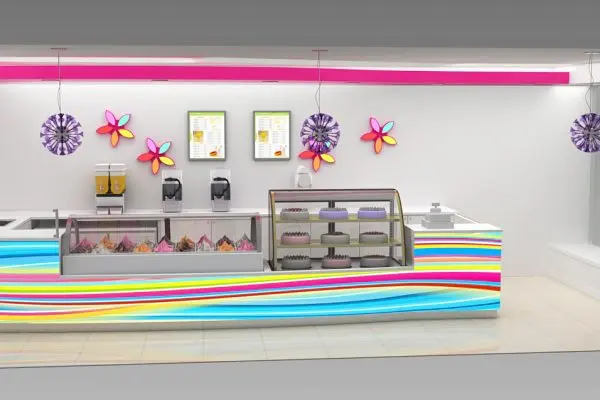Running a successful food kiosk in a busy location means more than just serving delicious food. You also need to invest in strong, high-quality infrastructure that can handle constant use. One of the most crucial aspects of any food kiosk setup is the store fixtures you choose. These fixtures not only impact the visual appeal of your space but also play a vital role in functionality, hygiene, and customer satisfaction.
In this guide, we’ll walk you through the top factors to consider when choosing store fixtures for your high-traffic food kiosk business.
Why Durability Matters in High-Traffic Environments
Whether your food kiosk is located in a mall, airport, or festival ground, high foot traffic is both a blessing and a challenge. While it means more sales opportunities, it also increases wear and tear on your physical space. Fixtures that aren’t made to withstand repeated use, spills, and movement will quickly deteriorate — costing you money in replacements and potentially harming your brand image.
That’s why durable store fixtures are essential. These are the foundation of your kiosk’s operations and must be chosen carefully.
1. Know Your Kiosk’s Workflow
Before buying any fixtures, you need to fully understand your food kiosk layout and how your staff moves during peak hours. Ask yourself:
- Where are the food prep and assembly areas?
- Where do customers place and receive orders?
- How much storage space is needed?
- Do you have a display section for snacks or beverages?
Your answers will guide the type and placement of fixtures — and ensure you don’t overcrowd your kiosk or block movement paths.
2. Prioritize Quality Materials
Material choice plays a major role in the durability and hygiene of your store fixtures. For high-traffic food kiosks, the most recommended materials include:
- Stainless Steel: Perfect for countertops and shelves because it’s strong, rust-resistant, and easy to clean.
- Tempered Glass: Ideal for display units, it’s more resistant to breaking than regular glass and offers a sleek look.
- HDPE (High-Density Polyethylene): Great for cabinets and prep areas because it’s food-safe and doesn’t absorb moisture or bacteria.
- Powder-Coated Metal: Used for racks and shelving units, it resists corrosion and scratches.
Avoid soft woods or low-grade plastics as they degrade quickly in demanding environments.
3. Choose Modular Fixtures for Flexibility
One great way to future-proof your food kiosk is to invest in modular store fixtures. These can be easily rearranged, added, or removed based on your changing needs or new menu items.
For example:
- Movable food prep tables
- Stackable storage units
- Adjustable display shelves
Modular systems are not only convenient but also save money in the long run, as you won’t need to purchase entirely new setups every time your business grows or shifts focus.
4. Consider Custom-Built Store Fixtures
If you want to stand out, consider getting custom store fixtures from reputable providers like RT Display. Custom fixtures ensure that everything fits your space perfectly and reflect your brand identity. Customization also allows for:
- Integrated signage or digital screens
- Brand-specific color themes
- Fixtures that match your menu flow
While the upfront cost is higher, custom solutions tend to be more durable and efficient than one-size-fits-all options.
5. Think About Hygiene and Safety
A busy food kiosk is a potential hotspot for spills, messes, and bacteria. That’s why choosing fixtures that support easy sanitation is non-negotiable.
Look for features like:
- Rounded corners to prevent dirt buildup
- Non-porous surfaces
- Easy-to-remove shelving or trays for quick cleaning
Also ensure your layout complies with local health and safety codes, including accessibility and fire safety.
6. Optimize Vertical and Under-Counter Space
In a small kiosk, every inch matters. Durable fixtures that use vertical space — like overhead shelves or wall-mounted racks — help reduce clutter and improve efficiency.
Similarly, don’t overlook under-counter storage. Built-in cabinets beneath counters can hold utensils, supplies, and cleaning tools — helping staff maintain a clean and organized workspace.
7. Energy-Efficient Fixtures for Display and Storage
If your kiosk includes refrigerated units or digital signage, opt for energy-efficient models. Not only do they lower utility bills, but they also reduce your environmental footprint — a great selling point for eco-conscious consumers.
Some display store fixtures even include LED lighting, motion sensors, and temperature regulation systems for added control.
8. Don’t Forget Aesthetics
Durability doesn’t mean boring. In fact, attractive fixtures help establish a professional and welcoming vibe. Your food kiosk should draw customers in with a clean, eye-catching design that matches your brand.
Some quick aesthetic tips:
- Stick to 2-3 consistent colors
- Use lighting to highlight key areas
- Keep displays tidy and symmetrical
Remember, first impressions are lasting impressions.
Where to Find High-Quality Fixtures
When it comes to setting up a food kiosk that combines durability, functionality, and style, it’s important to source your equipment from trusted providers.
Explore custom and ready-made solutions for store fixtures at RT Display. They specialize in fixtures that balance rugged construction with modern design — perfect for food kiosks operating in high-traffic locations.
For complete kiosk solutions, you can visit My Food Kiosk, where you’ll find turnkey setups, carts, and modular booths tailored to your needs.
Final Thoughts
The right fixtures are the backbone of any successful food kiosk. They impact workflow, customer experience, and your overall brand presentation. By choosing durable, hygienic, and thoughtfully designed store fixtures, you set your kiosk up for long-term success in even the busiest environments.
Whether you’re launching a new location or upgrading an existing setup, smart investments in quality infrastructure today will pay dividends tomorrow.
Also Read-When Life Changes Fast: What to Do with a Home You Can’t Keep


